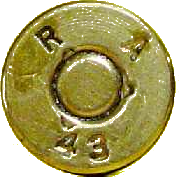Ysterhout Dot Net
The metallurgy of strain relief indicates that strain relief in cartridge brass begins to occur at a much lower temperature than what is required for annealing.
We can easily reconcile the physics to what we observe in practice.
- We know that uniformly strain relieving brass cartridge cases results in more uniform neck tension.
- We know we have to treat each case exactly the same way for best results.
- We know that untreated cases do not give as uniform neck tension as treated cases.
- We know that everybody who heat treats their brass uniformly, experiences more uniform neck tension.
From those facts, and some additional considerations, we can deduce some truths and identify a myth.
Consider how people determine the temperature they heat at. Some will say the metal must be heated to the point before it changes color. Some will say it has to be heated to the point where it just changes color. Some will say it must be a dull red. Some will use a temperature sensitive paste to determine how long to apply heat to reach a specific temperature. All of the aforementioned, if they apply their method consistently, will be rewarded with consistent neck tension. They will not have the same neck tension as each other, but it will be consistent within their batch.
The number of different methods that work suggest that the exact degree of heat application is not necessarily as precise as is generally accepted.
In each aforementioned case, the brass will have undergone differing levels of stress relief, which is not so important - what is of primary importance is that the strain in each brass case neck is reduced to the same strain level, or has the same neck tension.
The science of metallurgy tells us that stress relief in brass can occur from temperatures as low as 250 degrees celcius. The science of metallurgy tells us that unless the temperature of the brass is held constant for the requisite time per unit thickness, annealing cannot occur, even if the temperature is temporarily high enough to change the brass color in the flame.
This explains why so many different methods applied in so many different ways all yield the same result - more uniform neck tension. It is simply because cartridge brass stress relief occurs at 250 degrees celcius and above. It is not fussy. Wether your case necks get to 270 degrees or 600 degrees, stress relief will occur, the strain matrix will just remain greater for the lower temperature, and less for the higher, but most importantly, it will be uniformly so if the heat is applied the same way to each brass case. This is demonstrably proven by the many, differing accounts of how people anneal their brass, and still achieve more uniform neck tension.
From the information available in the paper from Norma, the first stress relief of the neck is around 350 degrees C, and the second is around 600 degreees C. Each is 14 seconds duration. The entire internet seems to think that a few seconds at 400 degrees C is enough to "anneal" brass. No. 400 degrees C is certainly enough for a bit of strain relief, and that's all.
The danger of overheating the neck is not in the changing of physical properties, which cannot occur unless the metal is annealed. The danger lies in applying enough heat for the brass to enter a plastic state, where it can deform under it's own weight. This means that the shape of the brass and wall thickness can be altered due to plastic flow, or melt. That is when the case becomes scrap. Brass can and does melt without being annealed at just over 900 degrees C.
Heating a case neck to some color change for one or two or five seconds cannot even begin the annealing process.
What it can do is reduce the strain in the metal matrix to a lower point than if less heat was applied.
The myth is the perception that brass cartridge necks have to be heated to one exact temperature for the smallest amount of time to be considered annealed.
That is a myth. False. Annealing never happens under those conditions. It is stress relief.
The truth is that the exact temperature is not so important. Stress relief in cartridge brass can happen over a range of temperature, from 250 degrees celcius to around 600 degrees celcius. What is important for uniform neck tension is that each case neck is heated in exactly the same way for exactly the same time.
To all the people who gave their time to create the multitude of case annealing videos on Youtube, waffling on about their interpretation of the significance of the progression of case annealing marks down the case body - those are not annealing marks, they are surface discoloration due to the application of heat, and have zero to do with annealing, as no annealing can possibly have taken place.



